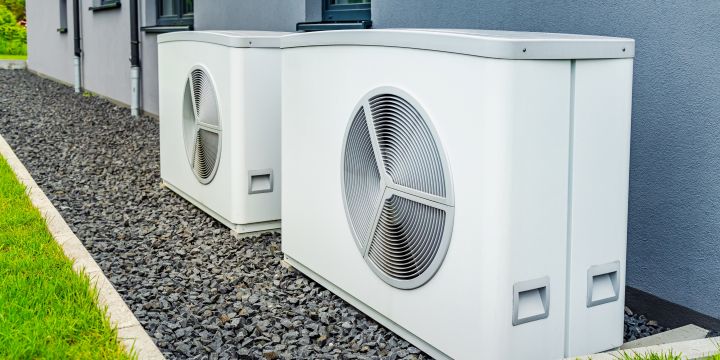Key Takeaways
- Air source heat pumps offer a reliable and efficient means of heating and cooling homes, reducing energy consumption significantly.
- Expected energy savings vary based on climate, installation quality, and home insulation.
- Government incentives can help offset installation costs, making air-source heat pumps more accessible to homeowners.
Introduction
As the demand for energy-efficient home heating and cooling solutions grows, air-source heat pumps (ASHPs) have become popular. Known for their capability to reduce energy consumption and carbon emissions, ASHPs are transforming how homeowners manage indoor climate control. By understanding the benefits and potential energy savings of ASHPs, homeowners can make informed decisions that contribute to environmental sustainability and financial savings.
How Air Source Heat Pumps Work
Air source heat pumps extract heat from the outside air—even in cold temperatures—and transfer it indoors to provide heating. During warmer months, the system reverses its operation to extract heat inside the house and release it outdoors, effectively cooling the home. This technology leverages the principles of refrigeration, offering a more energy-efficient alternative than traditional heating systems. The versatility and energy efficiency of ASHPs make them especially appealing for those exploring sustainable living options. Adopting an air source heat pump in Massachusetts can significantly optimize energy usage throughout the year.
Factors Affecting Energy Savings
While the potential for energy savings with air-source heat pumps is substantial, actual savings can vary based on several factors. One primary consideration is the climate; homes in milder climates experience more significant benefits from heat pumps since the systems can operate more efficiently without extreme temperature fluctuations. Additionally, the size and insulation quality of the home play crucial roles in determining how effectively an ASHP can maintain comfortable temperatures with minimal energy consumption.
Moreover, the quality of the heat pump installation significantly impacts performance and efficiency. Proper sizing and professional installation are critical to ensuring the system operates optimally. Engaging experienced technicians who understand the intricacies of ASHPs can help maximize energy savings and prolong the system’s lifespan.
Expected Energy Savings
One of the most compelling reasons for adopting air-source heat pumps is their impressive potential for reducing energy consumption. On average, homeowners can expect a 30-50% decrease in energy usage compared to traditional heating and cooling systems. This reduction translates to considerable savings on energy bills over time. Studies have shown that switching to an air-source heat pump can reduce annual heating costs by several hundred dollars, enhancing the overall return on investment.
Another vital aspect of energy savings with ASHPs is their ability to reduce greenhouse gas emissions. By lowering reliance on fossil fuels, these systems save money and decrease environmental impact, supporting broader sustainability goals.
Enhancing Efficiency with Smart Controls
Incorporating smart controls and programmable thermostats can maximize the energy-saving potential of air-source heat pumps. These technologies enable homeowners to set precise temperature schedules that align with their daily routines, reducing unnecessary energy usage when the house is unoccupied or less demanding.
In addition to scheduling features, many modern ASHP systems have connectivity options that allow remote adjustments via smartphone applications or voice-activated assistants. This flexibility provides additional convenience and control, empowering homeowners to adjust their systems in real-time to suit changing conditions or preferences.
Initial Costs and Long-term Benefits
The initial installation cost of an air source heat pump may seem daunting; however, numerous incentives exist to help offset these costs. Many governments and utility companies provide rebates, tax credits, and other financial assistance programs to encourage the adoption of energy-efficient technologies. While the upfront investment is significant, the long-term savings on energy bills often justify the expense, with many homeowners recouping installation costs within a few years.
Furthermore, air source heat pumps’ durability and low maintenance requirements contribute to their value proposition. With regular maintenance, ASHP systems can remain operational and efficient for 15 to 20 years, increasing the return on investment for homeowners seeking reliable, long-lasting heating and cooling solutions.
Case Studies: Real-world Applications
Numerous success stories from homeowners worldwide illustrate the significant benefits of transitioning to air-source heat pumps. For example, a family from a suburban neighborhood in Sweden reported a 40% decrease in their annual heating bills after switching to an ASHP system. The family also noted a marked improvement in indoor air quality, owing to the advanced filtration systems that many ASHP units feature.
Similarly, a residential community in Japan adopted air-source heat pumps in all new developments, resulting in substantial energy savings and a reduction in overall environmental impact. This community initiative highlights the potential of ASHPs at an individual level and as a collective approach to sustainable living practices.
Challenges and Considerations
Despite their numerous advantages, air-source heat pumps are not without challenges. Factors such as initial installation cost, space requirements, and potential noise levels are considerations that homeowners must weigh before deciding. Additionally, while ASHPs are highly efficient in moderate climates, their performance may diminish in regions with frigid temperatures, although technological advancements continue to enhance cold-weather efficiency.
To address these challenges, homeowners must conduct thorough research and consult with professionals who can provide insights into the suitability of ASHP systems for their specific needs and circumstances. Evaluating factors like home design, local climate conditions, and available incentives can help ensure a more informed and beneficial decision.
Conclusion
The shift towards air-source heat pumps represents a promising trend in sustainable home heating and cooling solutions. Homeowners can make knowledgeable decisions aligned with financial and environmental objectives by understanding the associated energy savings and long-term benefits. While challenges exist, the collective advantages offer compelling reasons to consider adopting this innovative technology. As more households transition to energy-efficient systems, the cumulative effect fosters a more sustainable future, benefitting individuals and the environment.



